Investigating Crime Trends, Strategies & Public Safety in Criminal Law
VerifiedAdded on 2023/04/21
|9
|2428
|183
Report
AI Summary
This report investigates crime trends and public safety in England and Wales, focusing on crime recording standards and the Crime Survey for England and Wales (CSEW). It details the National Crime Recording Standard (NCRS) used by police forces, emphasizing a victim-focused approach to crime reporting and classification. The report also explores the methodological changes in the CSEW to address repeat victimization and compares crime trends across different categories, including computer misuse, fraud, and violent offenses. Strengths and weaknesses of both police-recorded crime data and CSEW are analyzed, highlighting the importance of accurate crime measurement and the impact of recording practices. The analysis incorporates data from police records and HMICFRS inspections, revealing improvements in recording practices and the challenges of underreporting certain crimes. This document is available on Desklib, a platform offering study tools and resources for students.
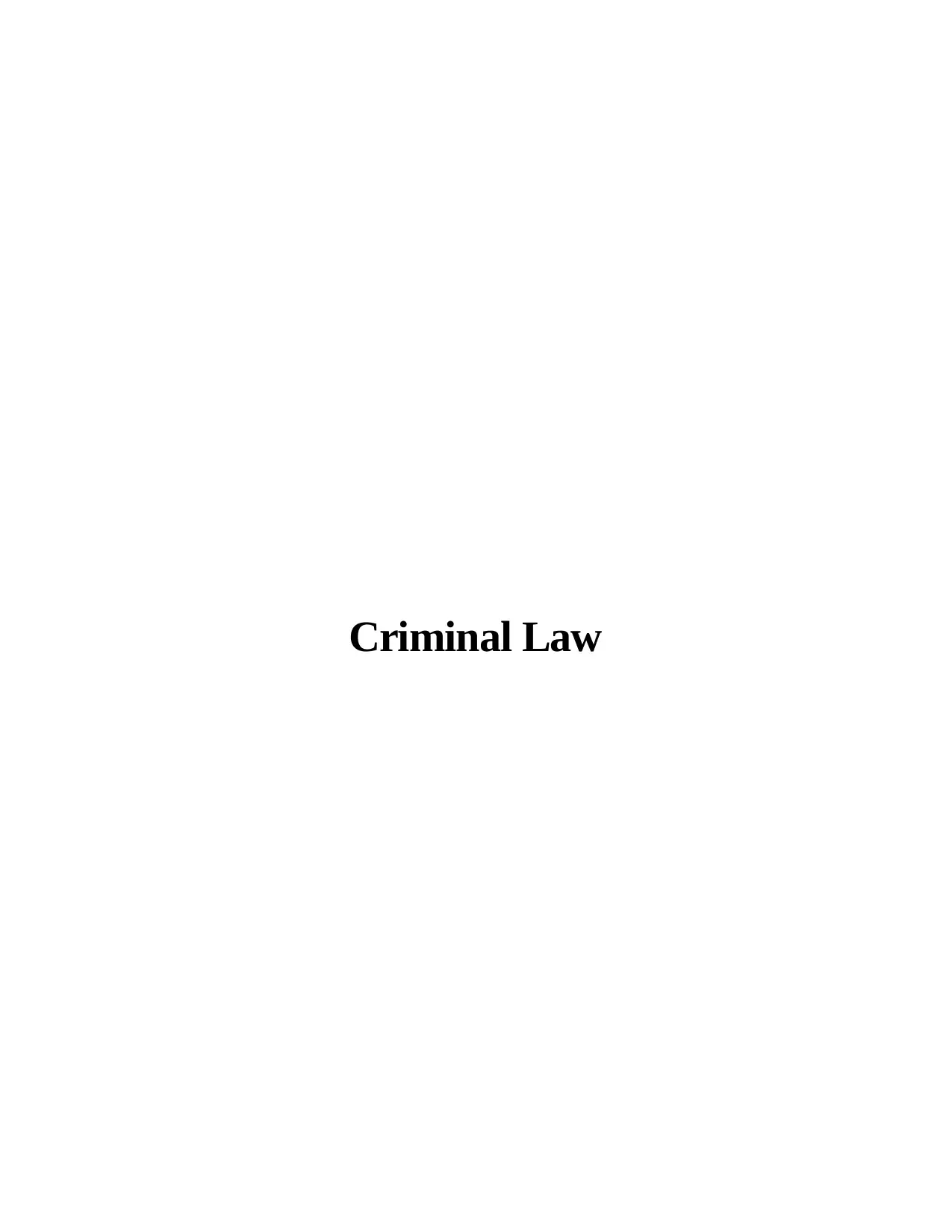
Criminal Law
Paraphrase This Document
Need a fresh take? Get an instant paraphrase of this document with our AI Paraphraser
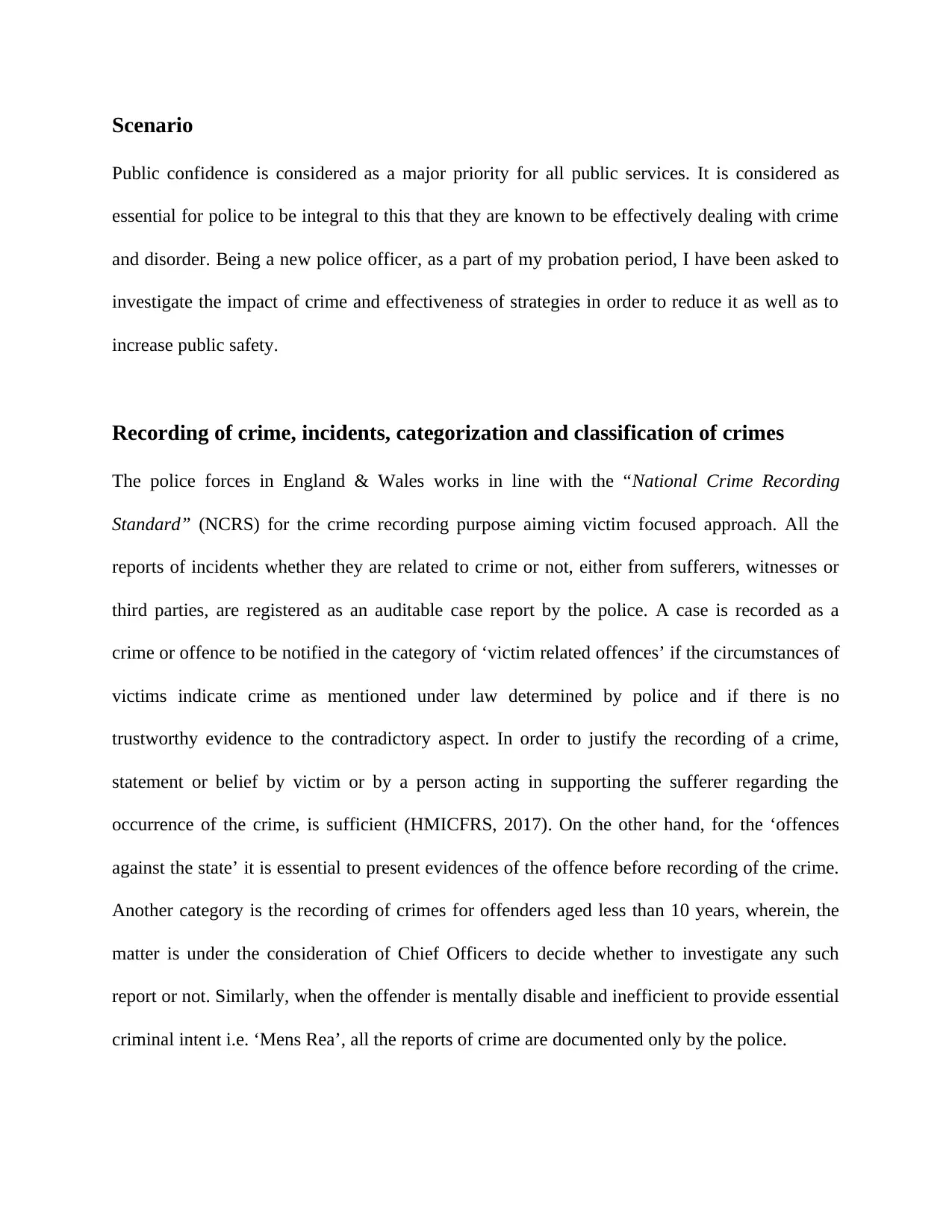
Scenario
Public confidence is considered as a major priority for all public services. It is considered as
essential for police to be integral to this that they are known to be effectively dealing with crime
and disorder. Being a new police officer, as a part of my probation period, I have been asked to
investigate the impact of crime and effectiveness of strategies in order to reduce it as well as to
increase public safety.
Recording of crime, incidents, categorization and classification of crimes
The police forces in England & Wales works in line with the “National Crime Recording
Standard” (NCRS) for the crime recording purpose aiming victim focused approach. All the
reports of incidents whether they are related to crime or not, either from sufferers, witnesses or
third parties, are registered as an auditable case report by the police. A case is recorded as a
crime or offence to be notified in the category of ‘victim related offences’ if the circumstances of
victims indicate crime as mentioned under law determined by police and if there is no
trustworthy evidence to the contradictory aspect. In order to justify the recording of a crime,
statement or belief by victim or by a person acting in supporting the sufferer regarding the
occurrence of the crime, is sufficient (HMICFRS, 2017). On the other hand, for the ‘offences
against the state’ it is essential to present evidences of the offence before recording of the crime.
Another category is the recording of crimes for offenders aged less than 10 years, wherein, the
matter is under the consideration of Chief Officers to decide whether to investigate any such
report or not. Similarly, when the offender is mentally disable and inefficient to provide essential
criminal intent i.e. ‘Mens Rea’, all the reports of crime are documented only by the police.
Public confidence is considered as a major priority for all public services. It is considered as
essential for police to be integral to this that they are known to be effectively dealing with crime
and disorder. Being a new police officer, as a part of my probation period, I have been asked to
investigate the impact of crime and effectiveness of strategies in order to reduce it as well as to
increase public safety.
Recording of crime, incidents, categorization and classification of crimes
The police forces in England & Wales works in line with the “National Crime Recording
Standard” (NCRS) for the crime recording purpose aiming victim focused approach. All the
reports of incidents whether they are related to crime or not, either from sufferers, witnesses or
third parties, are registered as an auditable case report by the police. A case is recorded as a
crime or offence to be notified in the category of ‘victim related offences’ if the circumstances of
victims indicate crime as mentioned under law determined by police and if there is no
trustworthy evidence to the contradictory aspect. In order to justify the recording of a crime,
statement or belief by victim or by a person acting in supporting the sufferer regarding the
occurrence of the crime, is sufficient (HMICFRS, 2017). On the other hand, for the ‘offences
against the state’ it is essential to present evidences of the offence before recording of the crime.
Another category is the recording of crimes for offenders aged less than 10 years, wherein, the
matter is under the consideration of Chief Officers to decide whether to investigate any such
report or not. Similarly, when the offender is mentally disable and inefficient to provide essential
criminal intent i.e. ‘Mens Rea’, all the reports of crime are documented only by the police.
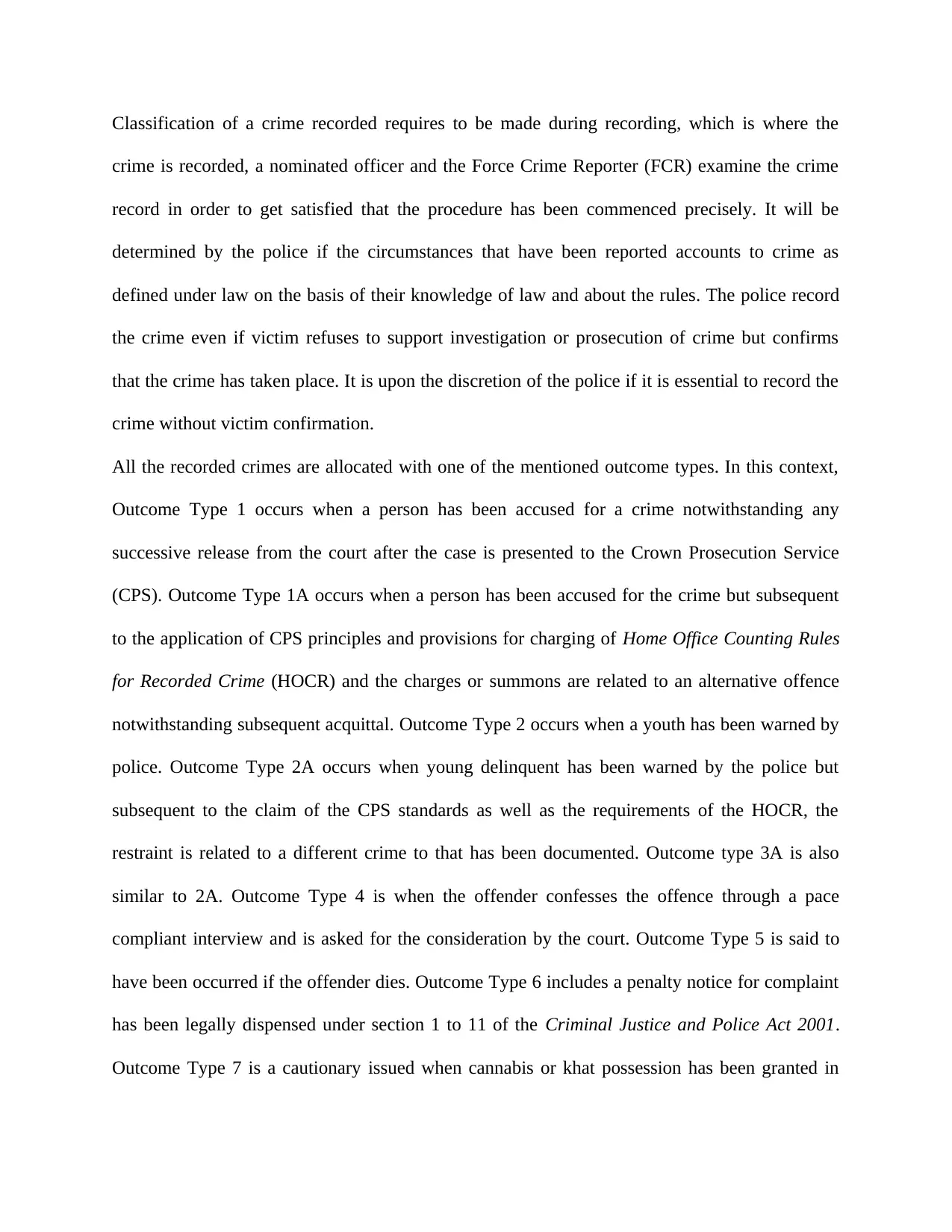
Classification of a crime recorded requires to be made during recording, which is where the
crime is recorded, a nominated officer and the Force Crime Reporter (FCR) examine the crime
record in order to get satisfied that the procedure has been commenced precisely. It will be
determined by the police if the circumstances that have been reported accounts to crime as
defined under law on the basis of their knowledge of law and about the rules. The police record
the crime even if victim refuses to support investigation or prosecution of crime but confirms
that the crime has taken place. It is upon the discretion of the police if it is essential to record the
crime without victim confirmation.
All the recorded crimes are allocated with one of the mentioned outcome types. In this context,
Outcome Type 1 occurs when a person has been accused for a crime notwithstanding any
successive release from the court after the case is presented to the Crown Prosecution Service
(CPS). Outcome Type 1A occurs when a person has been accused for the crime but subsequent
to the application of CPS principles and provisions for charging of Home Office Counting Rules
for Recorded Crime (HOCR) and the charges or summons are related to an alternative offence
notwithstanding subsequent acquittal. Outcome Type 2 occurs when a youth has been warned by
police. Outcome Type 2A occurs when young delinquent has been warned by the police but
subsequent to the claim of the CPS standards as well as the requirements of the HOCR, the
restraint is related to a different crime to that has been documented. Outcome type 3A is also
similar to 2A. Outcome Type 4 is when the offender confesses the offence through a pace
compliant interview and is asked for the consideration by the court. Outcome Type 5 is said to
have been occurred if the offender dies. Outcome Type 6 includes a penalty notice for complaint
has been legally dispensed under section 1 to 11 of the Criminal Justice and Police Act 2001.
Outcome Type 7 is a cautionary issued when cannabis or khat possession has been granted in
crime is recorded, a nominated officer and the Force Crime Reporter (FCR) examine the crime
record in order to get satisfied that the procedure has been commenced precisely. It will be
determined by the police if the circumstances that have been reported accounts to crime as
defined under law on the basis of their knowledge of law and about the rules. The police record
the crime even if victim refuses to support investigation or prosecution of crime but confirms
that the crime has taken place. It is upon the discretion of the police if it is essential to record the
crime without victim confirmation.
All the recorded crimes are allocated with one of the mentioned outcome types. In this context,
Outcome Type 1 occurs when a person has been accused for a crime notwithstanding any
successive release from the court after the case is presented to the Crown Prosecution Service
(CPS). Outcome Type 1A occurs when a person has been accused for the crime but subsequent
to the application of CPS principles and provisions for charging of Home Office Counting Rules
for Recorded Crime (HOCR) and the charges or summons are related to an alternative offence
notwithstanding subsequent acquittal. Outcome Type 2 occurs when a youth has been warned by
police. Outcome Type 2A occurs when young delinquent has been warned by the police but
subsequent to the claim of the CPS standards as well as the requirements of the HOCR, the
restraint is related to a different crime to that has been documented. Outcome type 3A is also
similar to 2A. Outcome Type 4 is when the offender confesses the offence through a pace
compliant interview and is asked for the consideration by the court. Outcome Type 5 is said to
have been occurred if the offender dies. Outcome Type 6 includes a penalty notice for complaint
has been legally dispensed under section 1 to 11 of the Criminal Justice and Police Act 2001.
Outcome Type 7 is a cautionary issued when cannabis or khat possession has been granted in
⊘ This is a preview!⊘
Do you want full access?
Subscribe today to unlock all pages.

Trusted by 1+ million students worldwide
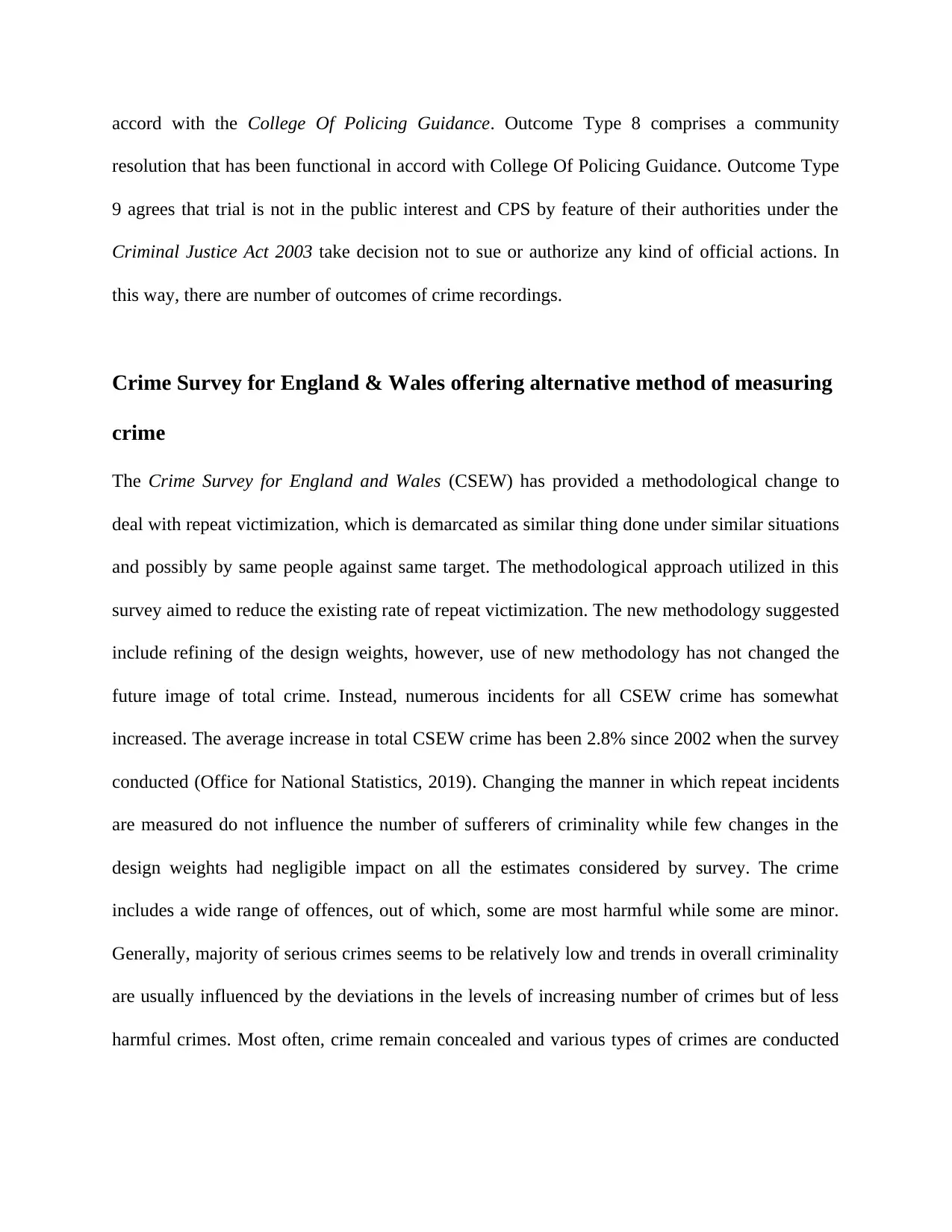
accord with the College Of Policing Guidance. Outcome Type 8 comprises a community
resolution that has been functional in accord with College Of Policing Guidance. Outcome Type
9 agrees that trial is not in the public interest and CPS by feature of their authorities under the
Criminal Justice Act 2003 take decision not to sue or authorize any kind of official actions. In
this way, there are number of outcomes of crime recordings.
Crime Survey for England & Wales offering alternative method of measuring
crime
The Crime Survey for England and Wales (CSEW) has provided a methodological change to
deal with repeat victimization, which is demarcated as similar thing done under similar situations
and possibly by same people against same target. The methodological approach utilized in this
survey aimed to reduce the existing rate of repeat victimization. The new methodology suggested
include refining of the design weights, however, use of new methodology has not changed the
future image of total crime. Instead, numerous incidents for all CSEW crime has somewhat
increased. The average increase in total CSEW crime has been 2.8% since 2002 when the survey
conducted (Office for National Statistics, 2019). Changing the manner in which repeat incidents
are measured do not influence the number of sufferers of criminality while few changes in the
design weights had negligible impact on all the estimates considered by survey. The crime
includes a wide range of offences, out of which, some are most harmful while some are minor.
Generally, majority of serious crimes seems to be relatively low and trends in overall criminality
are usually influenced by the deviations in the levels of increasing number of crimes but of less
harmful crimes. Most often, crime remain concealed and various types of crimes are conducted
resolution that has been functional in accord with College Of Policing Guidance. Outcome Type
9 agrees that trial is not in the public interest and CPS by feature of their authorities under the
Criminal Justice Act 2003 take decision not to sue or authorize any kind of official actions. In
this way, there are number of outcomes of crime recordings.
Crime Survey for England & Wales offering alternative method of measuring
crime
The Crime Survey for England and Wales (CSEW) has provided a methodological change to
deal with repeat victimization, which is demarcated as similar thing done under similar situations
and possibly by same people against same target. The methodological approach utilized in this
survey aimed to reduce the existing rate of repeat victimization. The new methodology suggested
include refining of the design weights, however, use of new methodology has not changed the
future image of total crime. Instead, numerous incidents for all CSEW crime has somewhat
increased. The average increase in total CSEW crime has been 2.8% since 2002 when the survey
conducted (Office for National Statistics, 2019). Changing the manner in which repeat incidents
are measured do not influence the number of sufferers of criminality while few changes in the
design weights had negligible impact on all the estimates considered by survey. The crime
includes a wide range of offences, out of which, some are most harmful while some are minor.
Generally, majority of serious crimes seems to be relatively low and trends in overall criminality
are usually influenced by the deviations in the levels of increasing number of crimes but of less
harmful crimes. Most often, crime remain concealed and various types of crimes are conducted
Paraphrase This Document
Need a fresh take? Get an instant paraphrase of this document with our AI Paraphraser
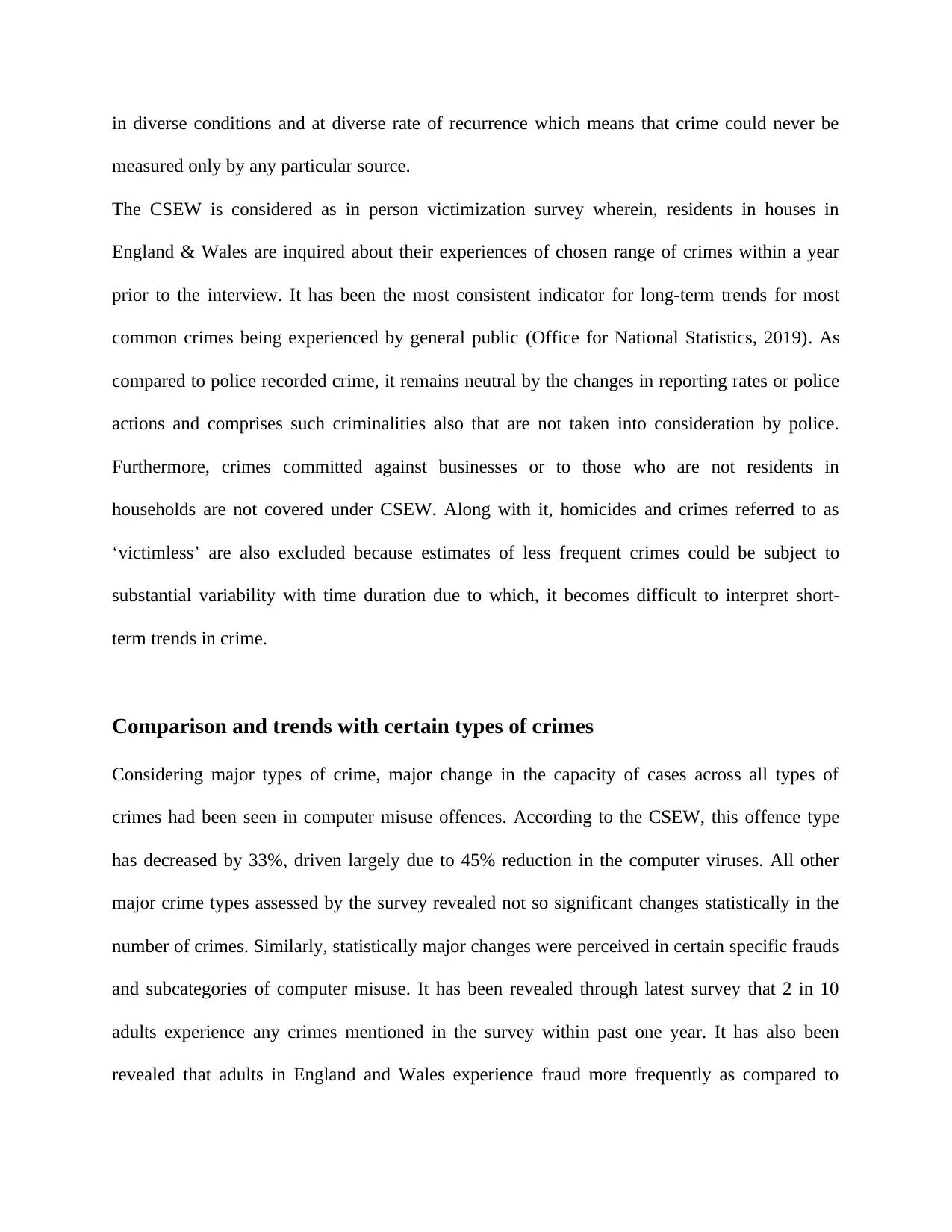
in diverse conditions and at diverse rate of recurrence which means that crime could never be
measured only by any particular source.
The CSEW is considered as in person victimization survey wherein, residents in houses in
England & Wales are inquired about their experiences of chosen range of crimes within a year
prior to the interview. It has been the most consistent indicator for long-term trends for most
common crimes being experienced by general public (Office for National Statistics, 2019). As
compared to police recorded crime, it remains neutral by the changes in reporting rates or police
actions and comprises such criminalities also that are not taken into consideration by police.
Furthermore, crimes committed against businesses or to those who are not residents in
households are not covered under CSEW. Along with it, homicides and crimes referred to as
‘victimless’ are also excluded because estimates of less frequent crimes could be subject to
substantial variability with time duration due to which, it becomes difficult to interpret short-
term trends in crime.
Comparison and trends with certain types of crimes
Considering major types of crime, major change in the capacity of cases across all types of
crimes had been seen in computer misuse offences. According to the CSEW, this offence type
has decreased by 33%, driven largely due to 45% reduction in the computer viruses. All other
major crime types assessed by the survey revealed not so significant changes statistically in the
number of crimes. Similarly, statistically major changes were perceived in certain specific frauds
and subcategories of computer misuse. It has been revealed through latest survey that 2 in 10
adults experience any crimes mentioned in the survey within past one year. It has also been
revealed that adults in England and Wales experience fraud more frequently as compared to
measured only by any particular source.
The CSEW is considered as in person victimization survey wherein, residents in houses in
England & Wales are inquired about their experiences of chosen range of crimes within a year
prior to the interview. It has been the most consistent indicator for long-term trends for most
common crimes being experienced by general public (Office for National Statistics, 2019). As
compared to police recorded crime, it remains neutral by the changes in reporting rates or police
actions and comprises such criminalities also that are not taken into consideration by police.
Furthermore, crimes committed against businesses or to those who are not residents in
households are not covered under CSEW. Along with it, homicides and crimes referred to as
‘victimless’ are also excluded because estimates of less frequent crimes could be subject to
substantial variability with time duration due to which, it becomes difficult to interpret short-
term trends in crime.
Comparison and trends with certain types of crimes
Considering major types of crime, major change in the capacity of cases across all types of
crimes had been seen in computer misuse offences. According to the CSEW, this offence type
has decreased by 33%, driven largely due to 45% reduction in the computer viruses. All other
major crime types assessed by the survey revealed not so significant changes statistically in the
number of crimes. Similarly, statistically major changes were perceived in certain specific frauds
and subcategories of computer misuse. It has been revealed through latest survey that 2 in 10
adults experience any crimes mentioned in the survey within past one year. It has also been
revealed that adults in England and Wales experience fraud more frequently as compared to
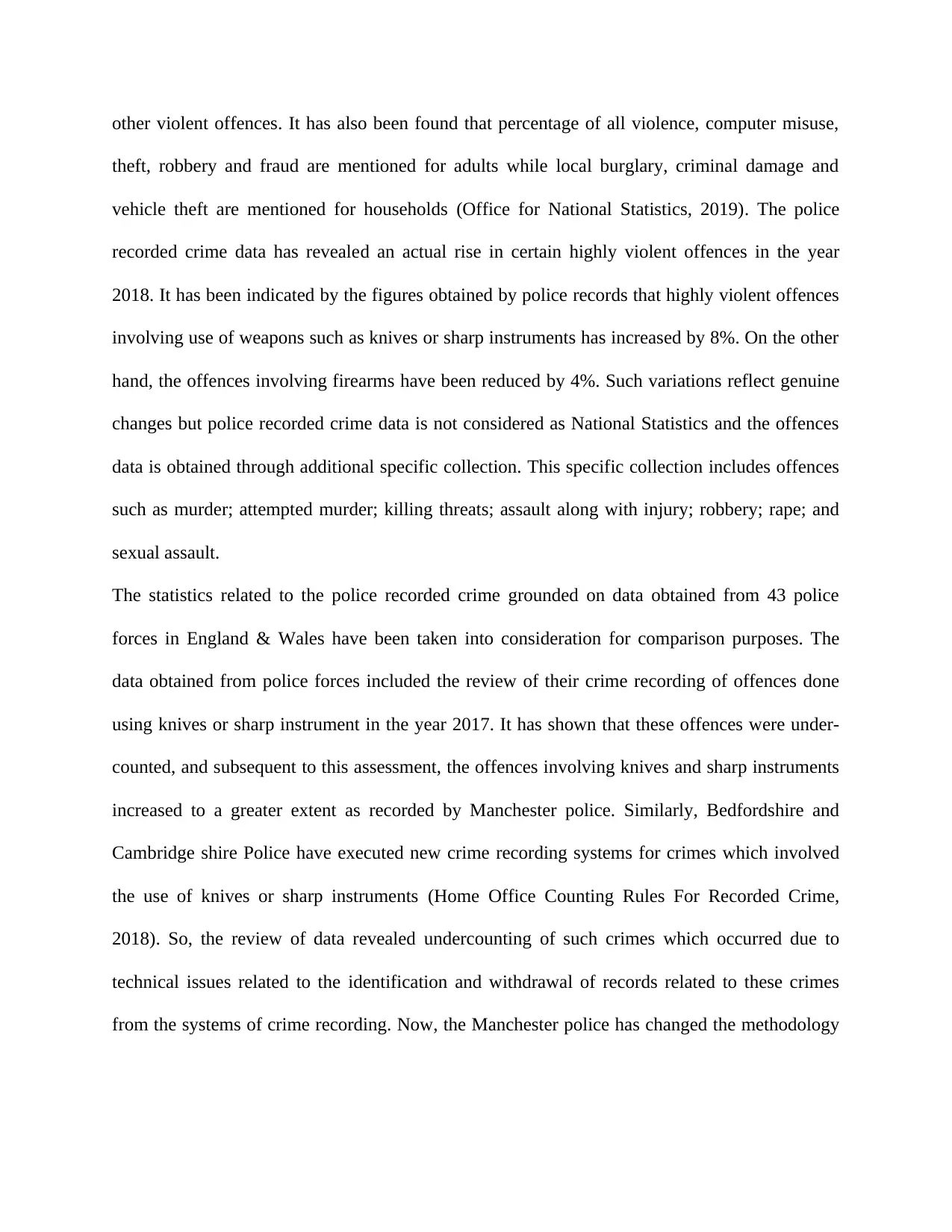
other violent offences. It has also been found that percentage of all violence, computer misuse,
theft, robbery and fraud are mentioned for adults while local burglary, criminal damage and
vehicle theft are mentioned for households (Office for National Statistics, 2019). The police
recorded crime data has revealed an actual rise in certain highly violent offences in the year
2018. It has been indicated by the figures obtained by police records that highly violent offences
involving use of weapons such as knives or sharp instruments has increased by 8%. On the other
hand, the offences involving firearms have been reduced by 4%. Such variations reflect genuine
changes but police recorded crime data is not considered as National Statistics and the offences
data is obtained through additional specific collection. This specific collection includes offences
such as murder; attempted murder; killing threats; assault along with injury; robbery; rape; and
sexual assault.
The statistics related to the police recorded crime grounded on data obtained from 43 police
forces in England & Wales have been taken into consideration for comparison purposes. The
data obtained from police forces included the review of their crime recording of offences done
using knives or sharp instrument in the year 2017. It has shown that these offences were under-
counted, and subsequent to this assessment, the offences involving knives and sharp instruments
increased to a greater extent as recorded by Manchester police. Similarly, Bedfordshire and
Cambridge shire Police have executed new crime recording systems for crimes which involved
the use of knives or sharp instruments (Home Office Counting Rules For Recorded Crime,
2018). So, the review of data revealed undercounting of such crimes which occurred due to
technical issues related to the identification and withdrawal of records related to these crimes
from the systems of crime recording. Now, the Manchester police has changed the methodology
theft, robbery and fraud are mentioned for adults while local burglary, criminal damage and
vehicle theft are mentioned for households (Office for National Statistics, 2019). The police
recorded crime data has revealed an actual rise in certain highly violent offences in the year
2018. It has been indicated by the figures obtained by police records that highly violent offences
involving use of weapons such as knives or sharp instruments has increased by 8%. On the other
hand, the offences involving firearms have been reduced by 4%. Such variations reflect genuine
changes but police recorded crime data is not considered as National Statistics and the offences
data is obtained through additional specific collection. This specific collection includes offences
such as murder; attempted murder; killing threats; assault along with injury; robbery; rape; and
sexual assault.
The statistics related to the police recorded crime grounded on data obtained from 43 police
forces in England & Wales have been taken into consideration for comparison purposes. The
data obtained from police forces included the review of their crime recording of offences done
using knives or sharp instrument in the year 2017. It has shown that these offences were under-
counted, and subsequent to this assessment, the offences involving knives and sharp instruments
increased to a greater extent as recorded by Manchester police. Similarly, Bedfordshire and
Cambridge shire Police have executed new crime recording systems for crimes which involved
the use of knives or sharp instruments (Home Office Counting Rules For Recorded Crime,
2018). So, the review of data revealed undercounting of such crimes which occurred due to
technical issues related to the identification and withdrawal of records related to these crimes
from the systems of crime recording. Now, the Manchester police has changed the methodology
⊘ This is a preview!⊘
Do you want full access?
Subscribe today to unlock all pages.

Trusted by 1+ million students worldwide
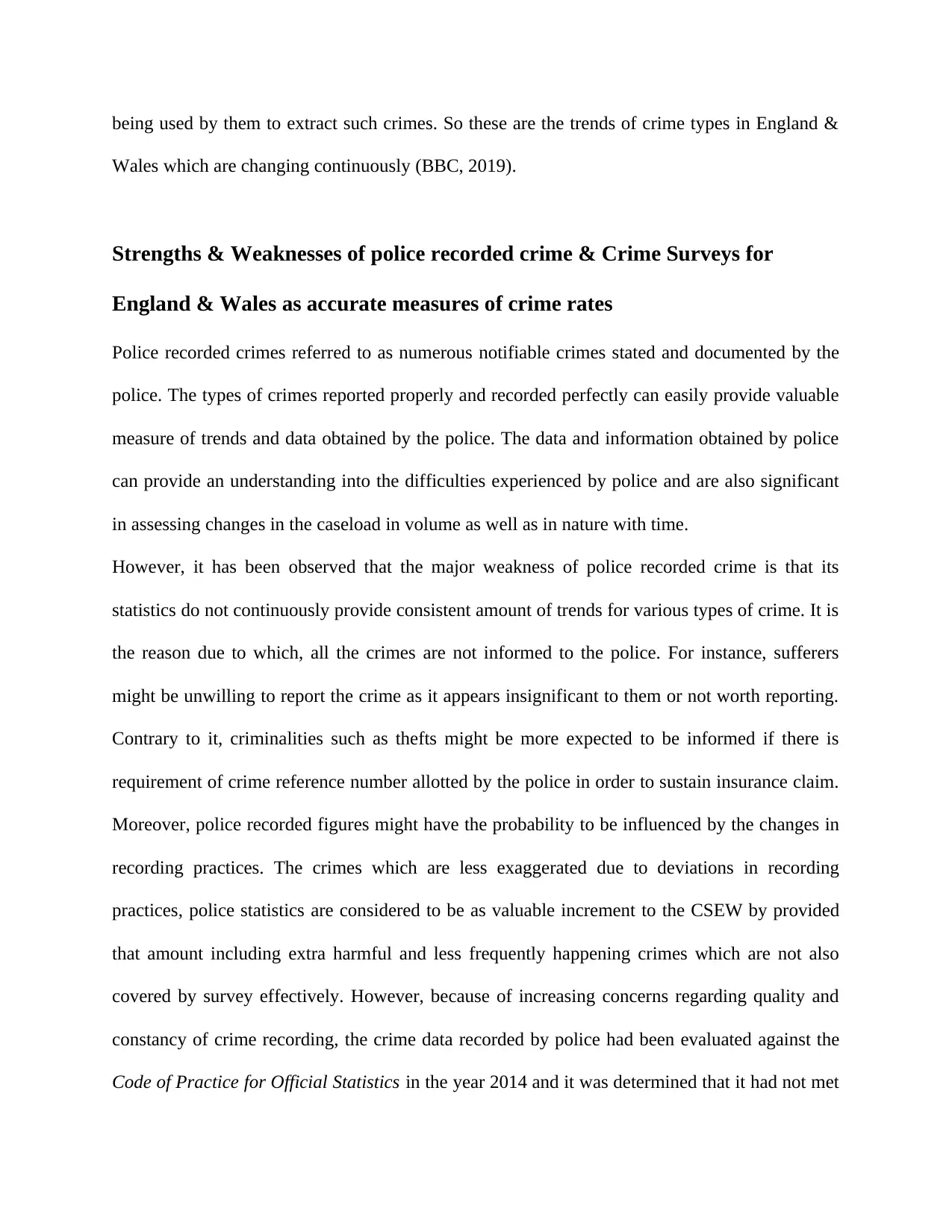
being used by them to extract such crimes. So these are the trends of crime types in England &
Wales which are changing continuously (BBC, 2019).
Strengths & Weaknesses of police recorded crime & Crime Surveys for
England & Wales as accurate measures of crime rates
Police recorded crimes referred to as numerous notifiable crimes stated and documented by the
police. The types of crimes reported properly and recorded perfectly can easily provide valuable
measure of trends and data obtained by the police. The data and information obtained by police
can provide an understanding into the difficulties experienced by police and are also significant
in assessing changes in the caseload in volume as well as in nature with time.
However, it has been observed that the major weakness of police recorded crime is that its
statistics do not continuously provide consistent amount of trends for various types of crime. It is
the reason due to which, all the crimes are not informed to the police. For instance, sufferers
might be unwilling to report the crime as it appears insignificant to them or not worth reporting.
Contrary to it, criminalities such as thefts might be more expected to be informed if there is
requirement of crime reference number allotted by the police in order to sustain insurance claim.
Moreover, police recorded figures might have the probability to be influenced by the changes in
recording practices. The crimes which are less exaggerated due to deviations in recording
practices, police statistics are considered to be as valuable increment to the CSEW by provided
that amount including extra harmful and less frequently happening crimes which are not also
covered by survey effectively. However, because of increasing concerns regarding quality and
constancy of crime recording, the crime data recorded by police had been evaluated against the
Code of Practice for Official Statistics in the year 2014 and it was determined that it had not met
Wales which are changing continuously (BBC, 2019).
Strengths & Weaknesses of police recorded crime & Crime Surveys for
England & Wales as accurate measures of crime rates
Police recorded crimes referred to as numerous notifiable crimes stated and documented by the
police. The types of crimes reported properly and recorded perfectly can easily provide valuable
measure of trends and data obtained by the police. The data and information obtained by police
can provide an understanding into the difficulties experienced by police and are also significant
in assessing changes in the caseload in volume as well as in nature with time.
However, it has been observed that the major weakness of police recorded crime is that its
statistics do not continuously provide consistent amount of trends for various types of crime. It is
the reason due to which, all the crimes are not informed to the police. For instance, sufferers
might be unwilling to report the crime as it appears insignificant to them or not worth reporting.
Contrary to it, criminalities such as thefts might be more expected to be informed if there is
requirement of crime reference number allotted by the police in order to sustain insurance claim.
Moreover, police recorded figures might have the probability to be influenced by the changes in
recording practices. The crimes which are less exaggerated due to deviations in recording
practices, police statistics are considered to be as valuable increment to the CSEW by provided
that amount including extra harmful and less frequently happening crimes which are not also
covered by survey effectively. However, because of increasing concerns regarding quality and
constancy of crime recording, the crime data recorded by police had been evaluated against the
Code of Practice for Official Statistics in the year 2014 and it was determined that it had not met
Paraphrase This Document
Need a fresh take? Get an instant paraphrase of this document with our AI Paraphraser
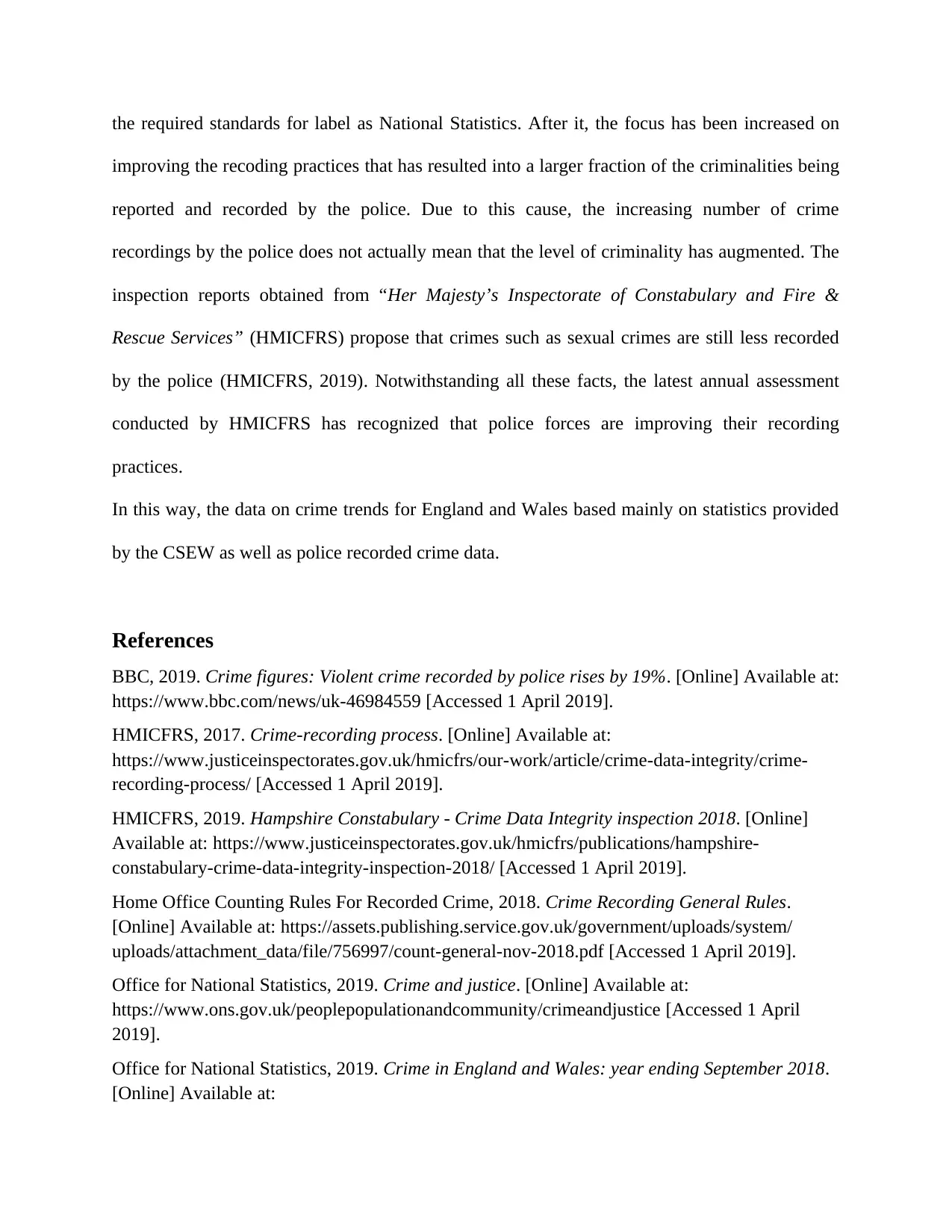
the required standards for label as National Statistics. After it, the focus has been increased on
improving the recoding practices that has resulted into a larger fraction of the criminalities being
reported and recorded by the police. Due to this cause, the increasing number of crime
recordings by the police does not actually mean that the level of criminality has augmented. The
inspection reports obtained from “Her Majesty’s Inspectorate of Constabulary and Fire &
Rescue Services” (HMICFRS) propose that crimes such as sexual crimes are still less recorded
by the police (HMICFRS, 2019). Notwithstanding all these facts, the latest annual assessment
conducted by HMICFRS has recognized that police forces are improving their recording
practices.
In this way, the data on crime trends for England and Wales based mainly on statistics provided
by the CSEW as well as police recorded crime data.
References
BBC, 2019. Crime figures: Violent crime recorded by police rises by 19%. [Online] Available at:
https://www.bbc.com/news/uk-46984559 [Accessed 1 April 2019].
HMICFRS, 2017. Crime-recording process. [Online] Available at:
https://www.justiceinspectorates.gov.uk/hmicfrs/our-work/article/crime-data-integrity/crime-
recording-process/ [Accessed 1 April 2019].
HMICFRS, 2019. Hampshire Constabulary - Crime Data Integrity inspection 2018. [Online]
Available at: https://www.justiceinspectorates.gov.uk/hmicfrs/publications/hampshire-
constabulary-crime-data-integrity-inspection-2018/ [Accessed 1 April 2019].
Home Office Counting Rules For Recorded Crime, 2018. Crime Recording General Rules.
[Online] Available at: https://assets.publishing.service.gov.uk/government/uploads/system/
uploads/attachment_data/file/756997/count-general-nov-2018.pdf [Accessed 1 April 2019].
Office for National Statistics, 2019. Crime and justice. [Online] Available at:
https://www.ons.gov.uk/peoplepopulationandcommunity/crimeandjustice [Accessed 1 April
2019].
Office for National Statistics, 2019. Crime in England and Wales: year ending September 2018.
[Online] Available at:
improving the recoding practices that has resulted into a larger fraction of the criminalities being
reported and recorded by the police. Due to this cause, the increasing number of crime
recordings by the police does not actually mean that the level of criminality has augmented. The
inspection reports obtained from “Her Majesty’s Inspectorate of Constabulary and Fire &
Rescue Services” (HMICFRS) propose that crimes such as sexual crimes are still less recorded
by the police (HMICFRS, 2019). Notwithstanding all these facts, the latest annual assessment
conducted by HMICFRS has recognized that police forces are improving their recording
practices.
In this way, the data on crime trends for England and Wales based mainly on statistics provided
by the CSEW as well as police recorded crime data.
References
BBC, 2019. Crime figures: Violent crime recorded by police rises by 19%. [Online] Available at:
https://www.bbc.com/news/uk-46984559 [Accessed 1 April 2019].
HMICFRS, 2017. Crime-recording process. [Online] Available at:
https://www.justiceinspectorates.gov.uk/hmicfrs/our-work/article/crime-data-integrity/crime-
recording-process/ [Accessed 1 April 2019].
HMICFRS, 2019. Hampshire Constabulary - Crime Data Integrity inspection 2018. [Online]
Available at: https://www.justiceinspectorates.gov.uk/hmicfrs/publications/hampshire-
constabulary-crime-data-integrity-inspection-2018/ [Accessed 1 April 2019].
Home Office Counting Rules For Recorded Crime, 2018. Crime Recording General Rules.
[Online] Available at: https://assets.publishing.service.gov.uk/government/uploads/system/
uploads/attachment_data/file/756997/count-general-nov-2018.pdf [Accessed 1 April 2019].
Office for National Statistics, 2019. Crime and justice. [Online] Available at:
https://www.ons.gov.uk/peoplepopulationandcommunity/crimeandjustice [Accessed 1 April
2019].
Office for National Statistics, 2019. Crime in England and Wales: year ending September 2018.
[Online] Available at:

https://www.ons.gov.uk/peoplepopulationandcommunity/crimeandjustice/bulletins/
crimeinenglandandwales/yearendingseptember2018 [Accessed 1 April 2019].
Office for National Statistics, 2019. The nature of violent crime in England and Wales: year
ending March 2018. [Online] Available at:
https://www.ons.gov.uk/peoplepopulationandcommunity/crimeandjustice/articles/
thenatureofviolentcrimeinenglandandwales/yearendingmarch2018 [Accessed 1 April 2019].
crimeinenglandandwales/yearendingseptember2018 [Accessed 1 April 2019].
Office for National Statistics, 2019. The nature of violent crime in England and Wales: year
ending March 2018. [Online] Available at:
https://www.ons.gov.uk/peoplepopulationandcommunity/crimeandjustice/articles/
thenatureofviolentcrimeinenglandandwales/yearendingmarch2018 [Accessed 1 April 2019].
⊘ This is a preview!⊘
Do you want full access?
Subscribe today to unlock all pages.

Trusted by 1+ million students worldwide
1 out of 9
Related Documents
Your All-in-One AI-Powered Toolkit for Academic Success.
+13062052269
info@desklib.com
Available 24*7 on WhatsApp / Email
![[object Object]](/_next/static/media/star-bottom.7253800d.svg)
Unlock your academic potential
Copyright © 2020–2025 A2Z Services. All Rights Reserved. Developed and managed by ZUCOL.



